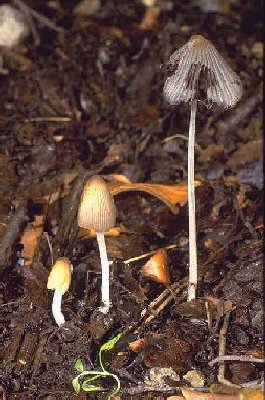Macroscopic features |
Closed pileus up to 22 x 16 mm, yellow-brown to ochre-brown at centre (Mu. 10 YR 4/6, 2.5 Y 6/8, K. & W. 5D5 to 4A/B7), paler towards margin, up to c. 35 mm in diam. when expanded. Lamellae free, narrow, white to blackish; L = c. 36., l = 1-3(-5). Stipe 40-100 x 1-3(-4) mm, white to greyish-white, pubescent. |
Microscopic features |
Spores [60,2,2] 10.6-14.2 x 6.7-8.4 µm, av. L= 12.1-12.6, av. B= 7.4-7.9 µm, Q= 1.35-1.80, av. Q= 1.55-1.70, ellipsoid to ovoid; germ pore eccentric, c. 2 µm wide. Basidia 18-38 x 8-10 µm, 4-spored. Pseudoparaphyses 4-6(-7) per basidium. Cheilocystidia 20-60 x 20-50 µm, globose, ellipsoid, ovoid to obovoid. Pleurocystidia absent. Pileocystidia 40-120 x 8-16 µm, lageniform with cylindrical to sometimes slightly tapering neck and equal, 3-8 µm wide apex. Sclerocystidia present, usually numerous. Clamp-connections present. |
Habitat |
Terrestrial on lawns, but also on wood-chips, usually fasciculate. Rather rare. |
Remarks |
The species most closely related to C. sclerocystidiosus are C. callinus and C. subpurpureus. |

[Copyright © by ]

[Copyright © by Hans Bender jbe8995374@aol.com]